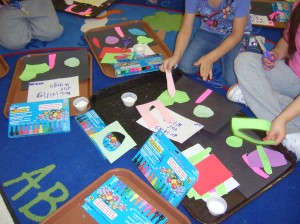Waiting for Wings
Posted by mrsmelva on 01/05/2010
We read this wonderful book by Lois Ehlert and discussed the pictures as well as the idea that the caterpillars were waiting for wings and so were the gardeners who had planted all the colourful flowers. Then I provided the students with white paper and markers for printing the title, black construction paper for a background and a wide variety of coloured paper to create their responses to the story. They used glue, scissors and markers to create many butterflies, caterpillars, chrysalids, and flowers (and some hearts).
There was a lot of discussion amongst the students about their work and a lot of sharing of ideas, not direct copying, but definitely getting inspiration from each other’s work.
This student had a very abstract interpretation, but he definitely picked up elements from the book in his choice of colours and in the zig zag lines. He worked diligently, with great concentration perfecting his cutting skills and deciding on the placement of the pieces.

A more representational interpretation, clockwise from lower left, chrysalis, flower, egg, butterfly, caterpillar

homework - thumbnail picture of the book cover and instructions to talk about the book together and draw or write about it
I displayed the completed homework on the same bulletin board as the art. There was a wide variety of detail in the responses, but overall it was well received.
And now for “baby” pictures of the actual caterpillars!
The little black dots are shed skins, as the caterpillars grow they shed their skins, the last shed will be the chrysalis forming. The cream coloured stuff is their food mix, which comes from the supplier. The little round yellow balls are foss – that’s poop, but with a fancy name. The kids really found that part interesting.
We open the containers for closer observation everyday, and although I gently push all of them down with a clean paintbrush, some very quickly climb back up to the top before I get done showing the kids the few on the lid that I am taking around the group.
We keep the containers in this larger one. On Friday I put some paper towels in the tops of the small containers as some of the caterpillars looked as if they might be ready to pupate. If they do, I will tape the towels with the chrysalids attached inside the larger container and some in the pavilion shown below.
Along with the pavilion, I have a butterfly life cycle puzzle, duck life cycle puzzle, two butterfly books and a duck book on this small table. I have many other life cycle books on the book racks shown on the left. The “big idea” for this inquiry is life cycles. I also have some life cycle picture cards. I made a set of each and mounted them on a long strip of construction paper, and then another set for matching. The strips can be joined with binder clips into a circle to demonstrate the fact that the life cycle goes round and round in a circle. I got the cards from sparklebox just click on minibeasts and you will find lots of neat stuff to print for teaching about life cycles.
Then he moved to the life cycle puzzle. I have had this puzzle for more than 20 years, and have a duck one just like it.
Sorry that this picture is so blurry, I took it in a hurry while writing a sub plan. I wasn’t sure if my directions for clipping made sense so I snapped a quick picture to show what I meant. I include pictures in my sub plans to help explain things and to show where stuff is in the classroom. I hate being gone, and hate writing sub plans but sometimes it is inevitable. With the sub, the children made their own chicken life cycle pictures as a colour, cut and glue activity from sparklebox. I will set out butterfly ones for them to do as a choice activity next week. They did the ones with the sub as a whole class activity as that works best with subs. There is also a frog set that I will be putting out in the near future. I have a stamp set of the butterfly life cycle and the frog cycle to set out soon, and some inflatable models that I hung from the ceiling in my old classroom, the ceiling is much lower in this room so I will have to think about what is best to do with them this year. Somewhere, not sure where, I have the small models of the life cycle that are shown on the page at the supplier link above. I hope I find them soon, will be looking in a couple of tubs and boxes tomorrow.
This student made this proboscis during work time. After he made his, several students made them. I did have to have a discussion about not sharing your proboscis with your friends (they were putting them in their mouths and pretending to sip nectar)! This was a completely spontaneous extension of the work we had done as a class.


















Brandi said
That is great. I just did a review w/ our kids on the Butterfly Garden. You all look like your having as much fun as we did!
Brandi said
He is the link to what we did, if you wanna check it out
http://livingsolagratia.blogspot.com/2010/04/watch-them-grow-then-let-them-go.html